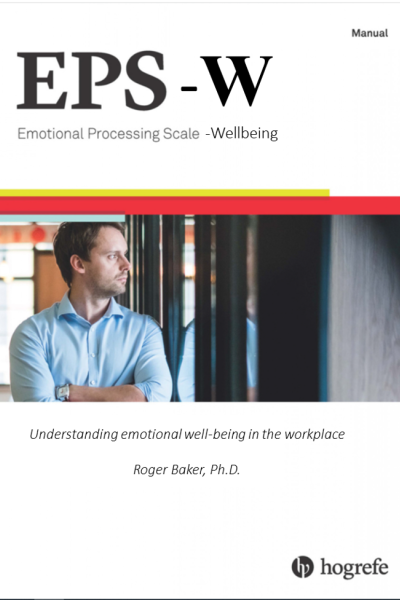In recent years, the wellbeing and mental health of employees has been highlighted, and companies and organisations are more aware of the need to be mindful of staff mental health issues.
The Covid pandemic and the mental health issues arising from it, along with new patterns of home and office working, have further emphasised the need to take the mental health of employees seriously.
The Emotional Processing Scale for Wellbeing (EPS-W) was created as a direct response to this need. By providing an organisation-wide progamme focussed on the mental health of employees, it offers staff insights and advice which relate to the prevention of mental health problems and creating resilience to stress.
Emotional processing applied to wellbeing at work
Events such as serious illness, the death of a loved one or a relationship breakdown have a significant emotional impact. Emotional processing refers to the way in which people accommodate that impact.
The team at Bournemouth University, led by Professor Baker, have investigated how people process emotional experiences and what impact this has on mental and physical wellbeing. They developed the Emotional Processing Scale (EPS), published in 2015 and subsequently translated into 19 languages.
In 2020, publishers Hogrefe Ltd were convinced that mental health and emotional wellbeing in the workplace was becoming a priority and their research team worked with Roger Baker over a two year period to produce a new version of the EPS to address emotional wellbeing at work.
The new scale differed from the original clinical version in being designed for the personal development of staff, rather than for clinical assessment and research. Roger Baker had used the original EPS in psychological therapy over six years and was able to incorporate his knowledge about the meaning of scores into a new automated Personal Insight Report for employees.
This report illustrates their emotional processing strengths and weaknesses and provides advice on personal development of emotional vulnerabilities and how to build resilience to stress.
After 18 months of development the system was piloted, modifications made, and the EPS-W was published by Hogrefe, using their online test platform, in August 2022.
What does the EPS-W scale measure?
The new wellbeing version of the Emotional Processing Scale taps into 5 significant emotional dimensions, which together expresses the person’s typical emotional processing style.
Together these dimensions provide a picture of our emotional resilience in dealing with the stressful life events which inevitably come our way. There are a wide range of different emotional processing styles, some conducive to healthy emotional wellbeing but others reflecting emotional vulnerability when faced with adverse life events.
How it works
The EPS-W is a 25-item questionnaire administered online in typically just five to ten minutes. It presents the respondent with a series of statements, and they must rate the extent to which each of the statements applies to the way they felt or acted during the last week.
Results can indicate a generally healthy approach to emotional processing (high scores), while lower scores can provide suggestions for enhancing their style. When lower scores are found, the Personal Insight Report includes Daily Emotions Charts that can help respondents examine and thus identify and even change the way they process their emotions. The EPS-W Personal Insight Report also includes Development Suggestions, which are intended to provide insight and guidance into how the respondent could practically apply the knowledge they have gained from their scores.
The goal of the assessment is to help individuals understand their own emotional processing style and provide guidelines for developing a more resilient style if appropriate.
The system comprises an Individual Online Assessment, Personal Insight Report, Technical Report for the professional administering the scale and an EPS-W manual explaining how professional administrators/ HR departments or Occupational Psychologists can set up and run the EPS-W in the workplace.
View an example copy of a Personal Insight Report on Sasha, a fictional employee
Improving wellbeing and effectiveness
The EPS-W may help to improve an individual’s wellbeing and effectiveness in occupational settings by facilitating their ability to process emotional events. This may involve programmes such as:
- coaching or training to enhance resilience and wellbeing
- on-boarding in occupations that experience high stress or emotional events (e.g. the emergency services)
- developing employees in customer facing roles (e.g. in a call centre) to help deal with the emotional reactions they may experience during, and after, difficult interactions with customers
- coaching individuals who are experiencing extremely stressful or demanding work environments, or are likely to be moving into such a role or environment
- training in leadership and management by helping leaders manage and use their emotions better when interacting with others, and as part of their decision-making process
- coaching personal development for individuals who want to experience improved relationships with colleagues and help them utilise emotions when making decisions
- helping those who are moving into new working practices, for example individuals returning to work in an office environment after remote working, and helping them cope with the emotional elements of that change (e.g. anxiety)
- supporting employees during times of organisational change (e.g. mergers and acquisitions; redundancies, etc.) by being able to process the emotional component of change more effectively
- identifying what may be impacting organisational problems, for example significant increases in sickness absence or staff turnover
The collateral effects of improved emotional wellbeing at work include improved wellbeing in the home, greater productivity, less time off through illness, less reliance on psychoactive medication and less medical illness. There is a strong interaction between emotions and disease and improving people’s emotional processing of stressful events can potentially have a profound effect on their susceptibility to physical illness.
 Professor Roger Baker
Professor Roger Baker